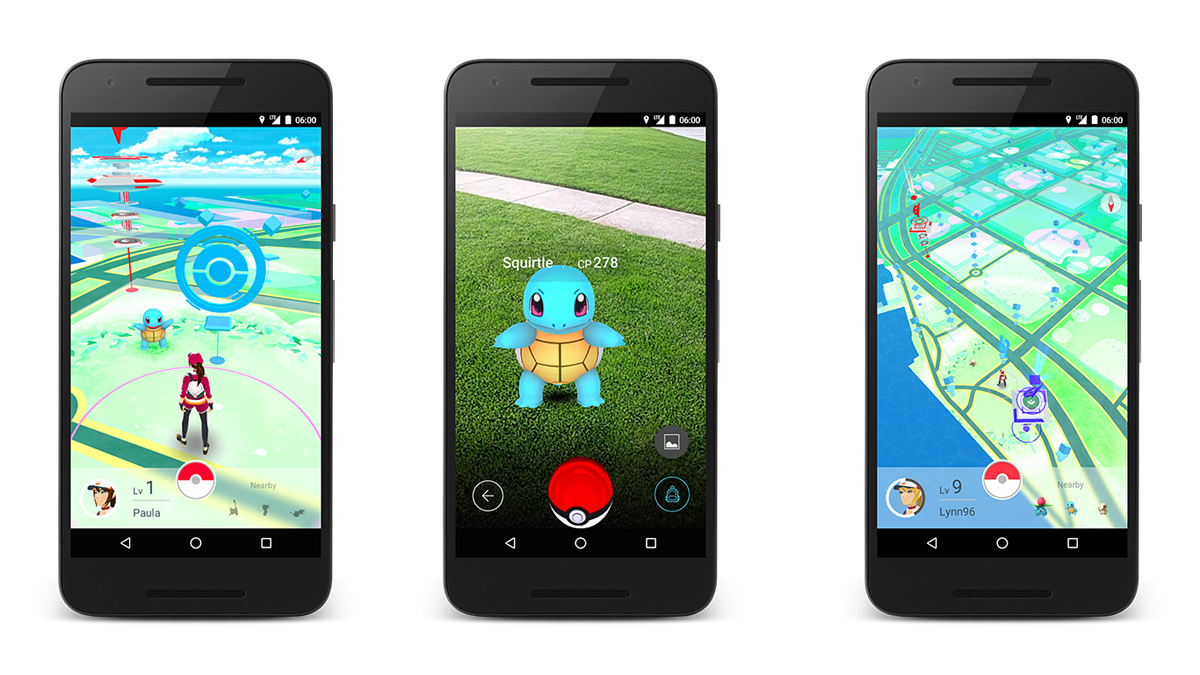I’m not what you could call a video game enthusiast. I think the last game I truly mastered was Tetris, and the only hazy memories I have of the original Pokémon games are my brothers shouting things to each other while playing GameBoy during car trips to see our grandmother.
Last week’s release of Pokémon Go, though, made me reconsider my lack of enthusiasm — in part because I see Pokémon Go’s augmented reality interface as a potentially useful tool for newsrooms.
I’ll explain the game first, in case you’re like me and don’t know a Charmander from a Pikachu. In Pokémon Go, like all of the Pokémon video games, players catch creatures called Pokémon and then train them to fight one another. What’s different about this new version, though, is that it uses an augmented reality interface, which means players walk around outside and capture Pokémon in real locations.
The game’s interface looks like a map. Once a Pokémon is spotted, players can see it (and take a picture of it) using their smartphone cameras. They can also walk around and capture useful items at other stops around town. If you’ve been out and about this week and noticed people in odd locations looking at their phones, they may have been playing the game.
It’s a fun, escapist activity that gets people off their couches and interacting with other people outside. But Pokémon Go is just the tip of the iceberg when it comes to this kind of technology: There will be other games and experiences that build on this kind of augmented reality and create immersive, real-world experiences for participants.
So what can journalists learn from the success of Pokémon Go, and how should we be thinking about possibilities for augmented reality beyond Google Glass? Here are a few ideas and questions to ponder.
How can journalists augment the experience within or alongside augmented reality games?
If people are traveling to various locations in your town or city, are there ways in which we could give players more information in the app or coupled alongside it? If Pokémon Go releases an API that allows coders to create in-app experiences, would it be possible to show restaurant reviews, infrastructure reports about various buildings, or news photos from that location?
From a reporting standpoint: Are there ways to report on the most trafficked locations? Are there ways to lead people playing the game to their next action? This seems like a perfect place for advertising, but it’s also one where information sharing can potentially flourish. Perhaps players visit a location, and then see archival news stories related to that location, or learn more about a place and are then prompted to take an action. Or perhaps players notice something in that location that’s worthy of a news story in and of itself.
How could newsrooms make themselves available to the many people who are participating in augmented reality spaces who are now part of a much larger network? What does commenting or communication look like in on these platforms? (Is it simply talking to others within the platform? External to it? And if so, is there a way to surface or capture that information that would indicate what players would like to learn more about?)
Working on a #PokemonGO-related news roundup. So far I have:
– Injuries
– Robbery
– Dead body
– Gathering in Australia
– Playing-while-black— Gabe Rosenberg (@GabrielJR) July 11, 2016
Who owns the data, who can access it, and what does it show?
The metadata being collected by Pokémon Go related to time and location is likely very valuable, and the power of a humongous networked group will likely build other connections within the data. But there are many ethical and privacy questions journalists should consider while thinking about the potential problems surfaced by the network (for an interesting deep dive that touches on some of the information security and ethical issues, check out this Twitter chain).
Yesterday, for instance, I chatted with a group of 12 people playing the game in my small North Carolina town. “This is what got me to turn location tracking on,” said one man. “It’s crazy how much data they’re getting.”
There also may be ways to augment this data collection with more information that might be potentially very helpful in the aggregate. For instance, could Pokémon Go players track and report potholes in a city? Could they track air quality? Could an augmented reality program say: “You’re in this spot where X thing happened. Would you like to do Y? Would you like to sign up for Z?” (And then how might those actions be facilitated?) Or: “You’ve looked for X creature at 7 p.m. at City Hall. Did you know there’s a City Council meeting taking place here tomorrow night?”
Can we create experiences with incentives to share progress so that participants (and non-participants) become part of a larger community?
Part of the genius of Pokémon Go is the way it has spread so quickly. People capture Pokémon and then take a picture of the capture, which they then share on social media. While doing so, they meet other people who are also playing the game, so there’s a natural social and sharing element built into the game.
I’ve written before about feedback loops that journalists can create to make audience sharing a key element in reporting stories. A similar feedback loop in Pokémon Go captures new players, as well as attention from people who aren’t even playing the game yet. There are now people taking pictures of people playing the game, which creates more excitement around Pokémon Go and captures more players or observers, which then continues the loop.
What kinds of storytelling experiences can augment augmented reality? Right now, Pokémon Go doesn’t have much storytelling built in about the places people are going to; players simply find their Pokémon and head to the next location. Opportunities exist to tell those stories, and to create journalism that thinks about place as a completely separate variable that can add layers of depth to a story. (Recommended listening: “Block of Time,” a “site-specific radio documentary/cell phone tour/super-hyper-local-journalism experiment” from Krissy Clark.)
Could a color-changing light bulb, which changes color based on a certain action in a game or experience, notify people about something in real life? Could various vibrations be used to notify users of different information? And, if so, what does that feel like? What could I trigger with my phone to make actions vary in real life?
Won't be long till we use AR widely for activism, media, politics. Pokemon Go shows us hidden sides of a city – now imagine that reapplied.
— an xiao mina (@anxiaostudio) July 11, 2016
What does social networking look like beyond phones?
A larger question for us to consider is what happens when someone’s feed is actually a device, which then incentivizes certain actions in the real world. How does commenting or feedback work, and how does the network then grow?
Pokémon Go is not really traveling through a traditional social graph, which relies on degrees-of-connection that people have with others. What does it mean when participants are introduced to others who they’re connected to by sharing space? What other things might they have in common besides playing the game? And how do they then communicate with one another? How could journalists facilitate this process, or gather information from this process?
Seeing an extraordinary number of in-person conversations between strangers of different races mediated by Pokémon Go. That's interesting.
— Anil Dash (@anildash) July 11, 2016
How can we think of augmented reality as enhancing the experience for the reader or viewer of traditional news?
Last night, I watched the Olympic Trials for track and field on my couch. I wished that I could see a normal “non-Olympian” run the 200 meter race because I wanted to be able to compare a normal person’s speed with the Olympic field. Currently, there’s no way to tell how fast Olympic runners are in comparison to regular people if you watch on TV because there’s no frame of reference. Is there a way to use augmented reality to do this type of comparative journalism? Could I watch something and see comparisons or be able to compare myself over time? And then how can we then use this concept for news itself?
I realize I’m asking a lot of questions in this piece, and there may not be answers to all of them. But I believe we have to grapple with them. As platforms and experiences immerse participants in a feed, a platform or in metadata layers between a platform and the outside world, we have to ask ourselves how journalism fits in — and then how we might think of journalism as potentially something people interact with when they may be doing something else entirely.
Thank you to NPR’s Gabriel Rosenberg, who wrote this great piece about Pokémon Go, as well as my brothers Steven and Mike for their thoughts on Pokémon.






